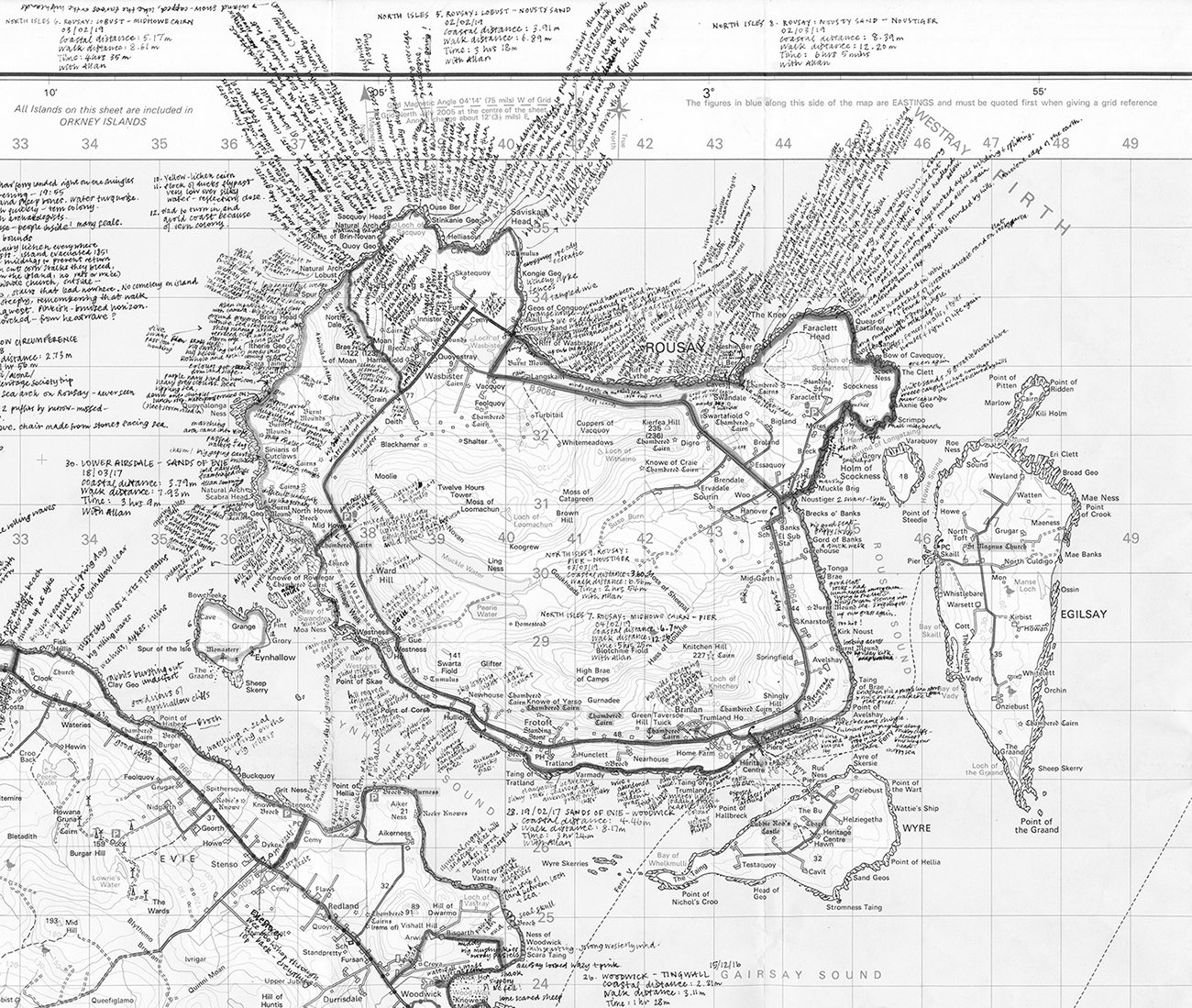I began walking the coastline of the mainland in March 2016, driven by a desire to really know Orkney. I wanted to walk and experience every section of the coast, not just the familiar places, but all the bits in-between.
I’d recently moved home after graduating from art school in Glasgow, and after years of experiencing life through a lens, I wanted to be free from the need to document everything, so I left my film cameras at home - also, I didn’t have the money or access to facilities to make analogue photographs. Instead I used the camera on my iPhone, which was unusual for me as my work prior to this was made using film.
I recorded the distance and duration of each walk using the GPS tracker on my phone, and marked each route with handwritten notes on an OS map. When I finished the last section of the mainland I didn’t want it to be over - so I decided to keep going, and I’m currently working my way one by one around the north isles.
For the first year or so of the project, I was working for Loganair as cabin crew, flying daily out of Kirkwall. This gave me a really interesting perspective of the islands - alternating between fleeting aerial expanses and slow, ground-level explorations. I could relive my completed walks from above, or plan new ones, examining obstacles and coastal formations from the air. I found this way of engaging with and understanding the landscape really exhilarating, this secret and privileged aspect that was part of my daily life.
In 2016 I joined up with a group of recent art graduates in Orkney to form the Móti Collective, and together we’ve held a series of exhibitions in which I’ve shown work from this project as it develops. In 2018 the Pier Arts Centre invited us to make work about the process of drawing - something which I hadn’t included as part of my work for years. I made a series of drawings of Orkney coastlines seen from a plane window, glimpses of Copinsay and Deerness caught between clouds when coming into land at Kirkwall Airport, and this slowly started to reveal the important connections for me between flying and walking.
More recently I’ve had access to facilities where I can process film and scan negatives again, so I’ve started bringing my ‘real’ camera - a Mamiya 645, using black and white medium format film - on the walks around the north isles. It’s bigger, heavier and requires a light meter reading for each photograph, so it slows me down. I’m still testing out the right balance between walking and photographing.
I was extremely lucky to be offered a place on a research residency studying the work of Gunnie Moberg and Margaret Tait in Orkney last year, and I’m still buoyed along by the momentum of all the discoveries made during that week. Gunnie’s aerial series ‘Stone Built’ - photographs of Orkney taken from the window of the Islander aircraft - led me first to North Ronaldsay, and later Papay and Rousay, and a selection of photographs I made while walking these coasts will be on show at Stills Gallery in Edinburgh from April 12 until June 2 2019.
Gunnie described the ancient structures of Orkney as ‘pieces of jewellery far below’. Her wording clarified something about my project - jewellery is small, personal, and can be collected and treasured.
These walks are my way of collecting Orkney piece by piece, my route-maps shrinking the experience of each journey into something small and intricate that can be kept forever.
For some people attending the show at Stills, Orkney will seem distant, imaginary. I can’t attempt to encapsulate the whole experience of the coastline, so I’ve just created a small window into it. Alongside three large-scale black and white film photographs from the north isles, I’m showing a series of 12 route-maps from my walks around the mainland, each captioned with notes lifted from my handwritten map. These show only where I walked - no sea, no land. Between these lines and words, the audience will be left to conjure their own version of Orkney.
There’s something very satisfying about walking a whole coastline, tracking it, writing each section down - it begins to sustain its own momentum, pulling you along, no matter how difficult the terrain or how horrible the weather. The memories from each walk get locked into each section of coastline - so that when I look at a map of Orkney, I can remember the colour of the waves that day, the feel of the frozen ground on another, or the stars coming out as I finished certain walks in darkness.
I didn’t realise when I set out how important it would become to me. When I first moved home after graduating, I wasn’t sure where I belonged, even though I grew up in Orkney. By walking the coastline, the brink between land and sea, I’ve really deepened my connection with my home - I’ve made Orkney mine.
Frances' book about her project, 'Undertow', will be launched at the Pier Arts Centre in Orkney on 29th February 2020. To celebrate the launch, a selection of photographs, maps, drawings and writing will also be on show at the Pier Arts Centre, opening on the 19th and running until the 29th of February.
Find out more about Frances and her work via her official website. You can also follow her on Instagram and Twitter.













